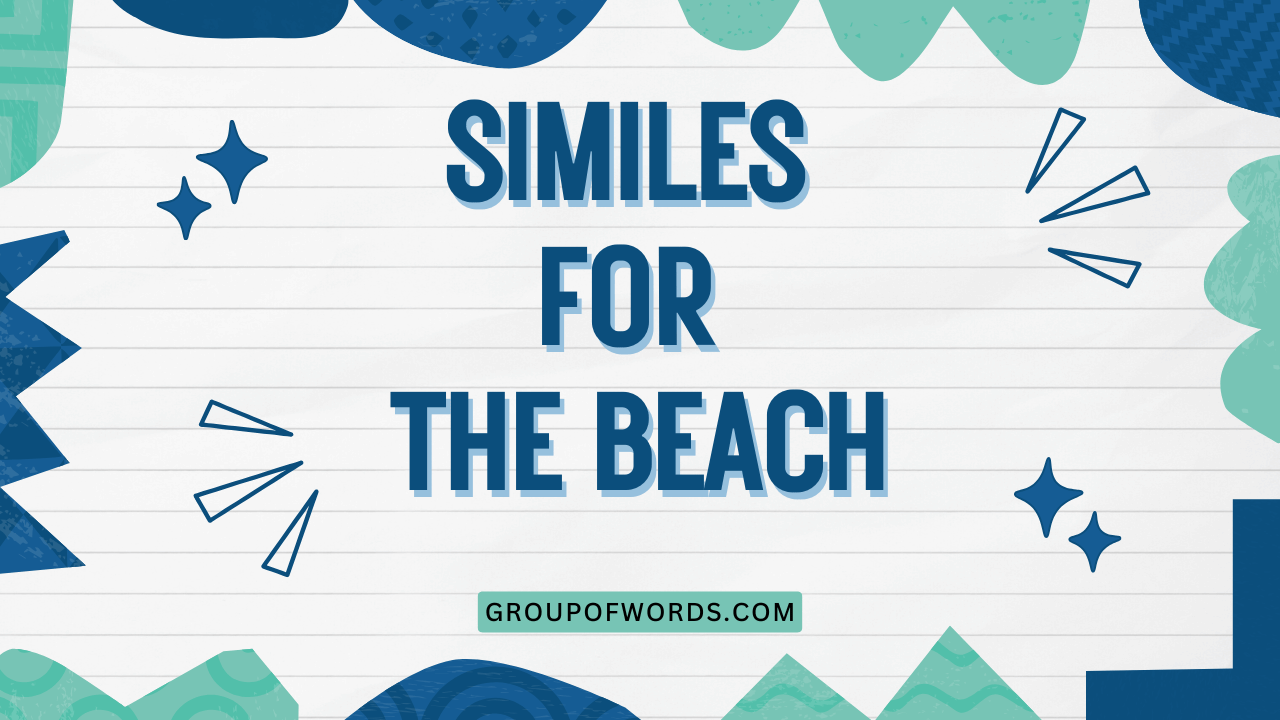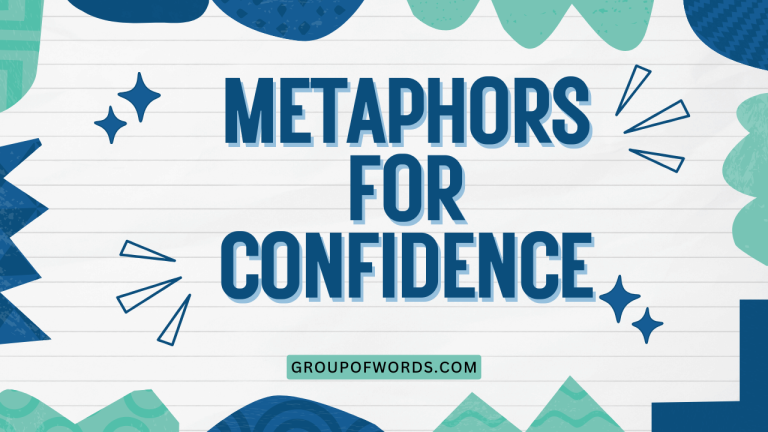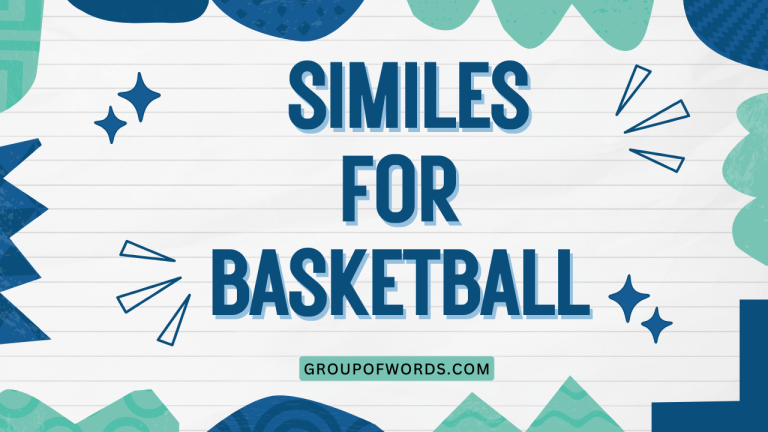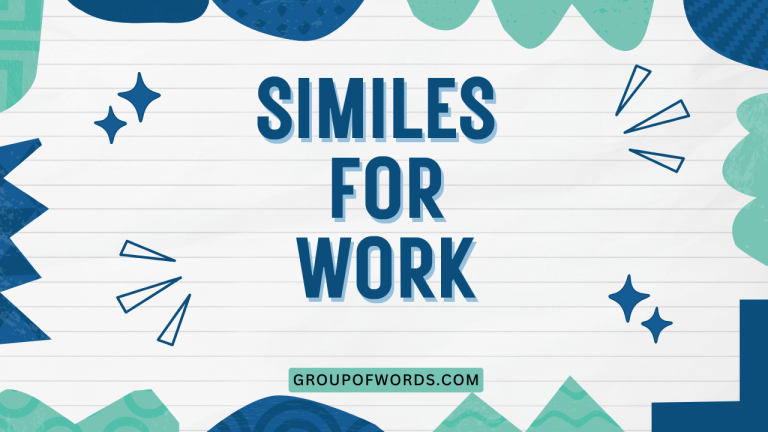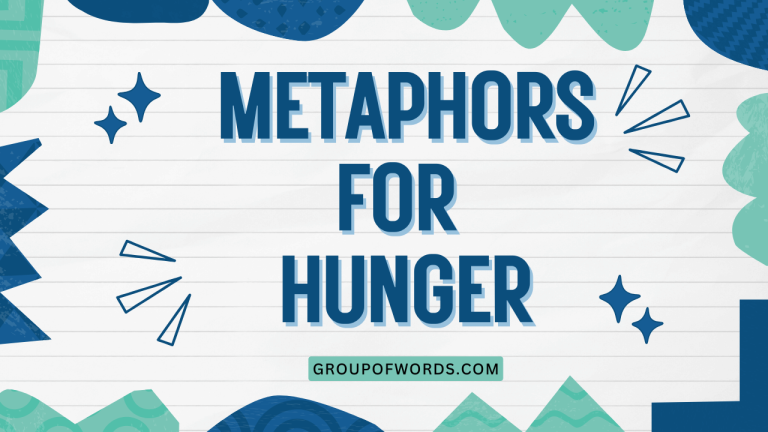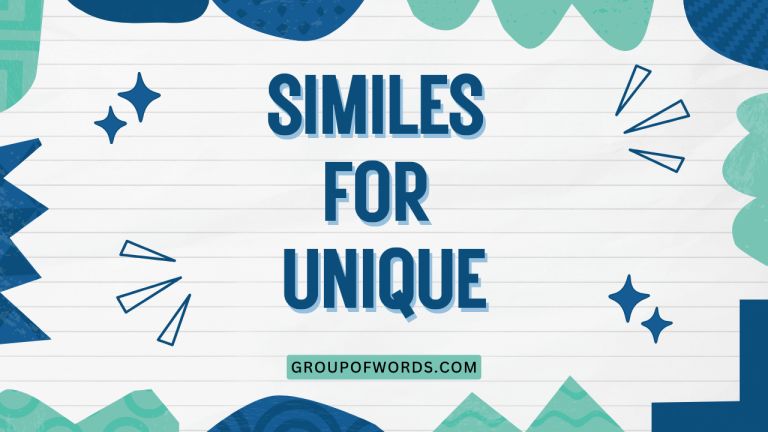Seashore Similes: Crafting Vivid Beach Descriptions
Similes are powerful tools that allow us to paint vivid pictures with words, drawing comparisons that resonate with our readers. When it comes to describing the beach, similes can transform ordinary sentences into evocative expressions that capture the essence of the ocean, sand, and sky.
This article delves into the art of using similes to describe the beach, providing a comprehensive guide for writers and English language learners alike. Understanding and mastering similes will not only enhance your descriptive writing skills but also deepen your appreciation for the beauty and complexity of the English language.
Whether you’re a student, a writer, or simply someone who loves the beach, this guide will provide you with the knowledge and tools you need to create stunning beach imagery through the use of similes.
This article is designed to be accessible to learners of all levels, from beginners to advanced students. It provides clear explanations, numerous examples, and practical exercises to help you master the art of crafting effective similes for beach descriptions.
By the end of this guide, you’ll be able to create compelling and memorable descriptions that transport your readers to the sandy shores and crashing waves of your favorite beach.
Table of Contents
- What is a Simile?
- The Structure of a Simile
- Types of Beach-Related Similes
- Examples of Beach Similes
- Usage Rules for Similes
- Common Mistakes with Similes
- Practice Exercises
- Advanced Topics in Similes
- Frequently Asked Questions
- Conclusion
What is a Simile?
A simile is a figure of speech that directly compares two different things using the words “like” or “as.” The purpose of a simile is to create a more vivid and imaginative description by highlighting the similarities between the two things being compared. Similes are a fundamental element of descriptive writing, allowing authors to create imagery and evoke emotions in their readers. They are widely used in literature, poetry, and everyday conversation to add color and depth to language.
Unlike metaphors, which state that one thing *is* another, similes acknowledge that the comparison is an analogy. This distinction is crucial because it maintains a sense of clarity and avoids potential confusion.
For instance, saying “The ocean is a roaring lion” is a metaphor, implying a direct equivalence. However, saying “The ocean roars like a lion” is a simile, suggesting a similarity in sound but not an identity.
Similes function to make abstract concepts more concrete and relatable. By comparing something unfamiliar to something familiar, similes help readers understand and visualize the subject matter more effectively.
In the context of describing the beach, similes can bring the sensory experiences of the shore to life, allowing readers to feel the warmth of the sun, hear the crashing of the waves, and see the endless expanse of the ocean.
The Structure of a Simile
Understanding the structure of a simile is crucial for creating effective and clear comparisons. A simile typically consists of three essential components:
- The Subject: The thing being described.
- The Linking Word: “Like” or “as.”
- The Object of Comparison: The thing to which the subject is being compared.
The basic formula for a simile is: Subject + Linking Word + Object of Comparison. For example, in the simile “The sand is like gold dust,” the subject is “the sand,” the linking word is “like,” and the object of comparison is “gold dust.”
The order of these components can sometimes be varied for stylistic effect, but the core elements remain the same. For example, instead of saying “The waves crashed like thunder,” you could say “Like thunder, the waves crashed.” This inversion can add emphasis or create a more poetic rhythm.
It’s important to ensure that the comparison is logical and meaningful. The object of comparison should share a relevant characteristic with the subject.
A well-constructed simile not only enhances the description but also provides insight or adds a new dimension to the subject.
Types of Beach-Related Similes
Beach-related similes can be categorized based on the type of sensory experience or comparison they evoke. Here are some common types:
Sensory Similes
Sensory similes appeal to the five senses: sight, sound, smell, taste, and touch. These similes help readers experience the beach through vivid sensory details.
For instance:
- Sight: “The water was as clear as glass.”
- Sound: “The waves crashed like a symphony.”
- Smell: “The air smelled like salt and seaweed.”
- Touch: “The sand felt like warm silk.”
Comparative Similes
Comparative similes highlight specific similarities between the beach and other objects or phenomena. These similes often focus on qualities such as size, color, or texture.
For instance:
- Size: “The beach stretched as far as the eye could see.”
- Color: “The sunset was as vibrant as a painting.”
- Texture: “The shells were as smooth as polished stones.”
Metaphorical Similes
Metaphorical similes use more abstract or imaginative comparisons to create a deeper meaning. These similes often evoke emotions or ideas beyond the literal description.
For instance:
- “The beach was like a blank canvas, waiting to be filled with memories.”
- “The ocean’s rhythm was like a heartbeat, constant and soothing.”
- “The seagulls cried like lonely souls, searching for connection.”
Examples of Beach Similes
Here are some extensive examples of beach similes, organized by category, to illustrate how they can be used to describe different aspects of the beach:
Similes for Sand
Sand is a primary element of the beach, and similes can help capture its texture, color, and feel. The following table provides numerous examples of similes that describe sand:
| Simile | Explanation |
|---|---|
| The sand was as hot as fire. | Emphasizes the intense heat of the sand. |
| The sand felt like powdered sugar. | Describes a fine, soft texture. |
| The sand glittered like diamonds in the sun. | Highlights the sparkling quality of the sand. |
| The sand was as coarse as sandpaper. | Describes a rough texture. |
| The sand flowed through my fingers like water. | Emphasizes the fluidity of the sand. |
| The sand was as white as snow. | Describes a bright, pure color. |
| The sand felt like a warm blanket. | Highlights the comforting warmth of the sand. |
| The sand was as soft as a cloud. | Describes a gentle, yielding texture. |
| The sand stretched out like a golden carpet. | Creates a visual image of a wide, golden expanse. |
| The sand was as fine as dust. | Describes a very fine texture. |
| The sand burned my feet like hot coals. | Emphasizes the burning sensation of hot sand. |
| The sand felt like tiny beads. | Describes a granular texture. |
| The sand shifted under my weight like quicksand. | Highlights the unstable nature of the sand. |
| The sand was as dry as a desert. | Describes a lack of moisture. |
| The sand clung to my skin like glue. | Emphasizes the stickiness of the sand. |
| The sand was as smooth as silk. | Describes a very smooth texture. |
| The sand was sculpted by the wind like art. | Highlights the artistic shapes created by the wind. |
| The sand was as yellow as butter. | Describes a rich, yellow color. |
| The sand tickled my toes like feathers. | Emphasizes the gentle, tickling sensation. |
| The sand was as hard as concrete. | Describes a firm, solid texture. |
| The sand was like a giant sandbox. | Relates the beach to a familiar childhood experience. |
| The sand was as inviting as a soft bed. | Highlights the comforting and inviting nature of the sand. |
| The sand was covered in footprints like a diary page. | Emphasizes the stories told by footprints in the sand. |
| The sand was cool underfoot, like stepping onto a marble floor. | Highlights the cool sensation of the sand. |
| The sand was as unforgiving as broken glass. | Describes a harsh and potentially harmful texture. |
Similes for Water
The ocean is another central element of the beach experience. Here are some similes to describe various aspects of the water:
| Simile | Explanation |
|---|---|
| The water was as blue as sapphires. | Describes a deep, rich blue color. |
| The waves crashed like thunder. | Emphasizes the loud, powerful sound of the waves. |
| The water sparkled like a million diamonds. | Highlights the shimmering quality of the water. |
| The water felt like liquid ice. | Describes a very cold temperature. |
| The ocean stretched out like a vast, blue blanket. | Creates a visual image of a large, expansive body of water. |
| The water was as calm as a millpond. | Describes a peaceful, still body of water. |
| The waves danced like ballerinas. | Emphasizes the graceful, rhythmic movement of the waves. |
| The water was as clear as crystal. | Describes a transparent, pure quality. |
| The waves roared like angry beasts. | Highlights the aggressive, powerful nature of the waves. |
| The water felt like a gentle caress. | Describes a soft, soothing sensation. |
| The ocean was as deep as my sorrow. | Evokes a feeling of profound sadness or depth. |
| The water was as green as emeralds. | Describes a vibrant green color. |
| The waves whispered secrets like old friends. | Emphasizes the gentle, murmuring sound of the waves. |
| The water was as salty as tears. | Describes the salty taste of the ocean. |
| The ocean was like a restless spirit. | Highlights the constant movement and energy of the ocean. |
| The water was as dark as night. | Describes a deep, dark color. |
| The waves crashed against the shore like an army. | Emphasizes the powerful, relentless force of the waves. |
| The water felt like silk against my skin. | Describes a smooth, luxurious sensation. |
| The ocean was as vast as my imagination. | Highlights the limitless potential of the ocean. |
| The water was as cold as a witch’s heart. | Describes a very cold and unwelcoming temperature. |
| The waves moved like a swaying snake. | Emphasizes the sinuous movement of the waves. |
| The water tasted as briny as the sea itself. | Highlights the intensely salty flavor of the water. |
| The ocean’s surface was as smooth as glass until a breeze rippled it. | Describes the water’s initial stillness and subsequent disturbance. |
| The water was as inviting as a cool drink on a hot day. | Highlights the refreshing and appealing nature of the water. |
| The waves broke over the rocks like a child smashing toys. | Emphasizes the destructive force of the waves. |
Similes for Sky
The sky above the beach contributes significantly to the overall atmosphere. Here are some similes that describe the sky:
| Simile | Explanation |
|---|---|
| The sky was as blue as a robin’s egg. | Describes a light, vibrant blue color. |
| The clouds floated like cotton candy. | Emphasizes the light, fluffy appearance of the clouds. |
| The sunset burned like a fiery inferno. | Highlights the intense colors and heat of the sunset. |
| The sky was as gray as a battleship. | Describes a dull, overcast color. |
| The stars twinkled like diamonds scattered across velvet. | Emphasizes the sparkling quality of the stars. |
| The sky was as clear as a bell. | Describes a transparent, cloudless sky. |
| The clouds raced across the sky like wild horses. | Highlights the fast, dynamic movement of the clouds. |
| The sunset was as vibrant as a peacock’s feathers. | Describes a colorful, radiant sunset. |
| The sky was as dark as a raven’s wing. | Describes a deep, dark color. |
| The moon hung in the sky like a silver coin. | Emphasizes the round, metallic appearance of the moon. |
| The sky was as vast as the ocean below. | Highlights the immense size of the sky. |
| The clouds were like brushstrokes in a painting. | Emphasizes the artistic quality of the clouds. |
| The sunrise painted the sky like a masterpiece. | Highlights the beautiful, colorful effect of the sunrise. |
| The sky was as changeable as the sea. | Describes the dynamic and unpredictable nature of the sky. |
| The stars shone like distant headlights. | Emphasizes the brightness and clarity of the stars. |
| The sky was as empty as a blank page. | Describes a clear, featureless sky. |
| The clouds gathered like an approaching army. | Emphasizes the ominous feeling of gathering storm clouds. |
| The sunset bled across the sky like watercolor. | Highlights the gradual blending of colors during sunset. |
| The sky felt as heavy as lead before the storm. | Describes the oppressive feeling of the sky before a storm. |
| The moon glowed like a pearl in the night. | Emphasizes the soft, luminous quality of the moon. |
| The sky was as unforgiving as a judge’s gaze. | Describes a harsh and unwelcoming sky. |
| The clouds billowed like sails on the horizon. | Emphasizes the large, full shape of the clouds. |
| The sunrise crept over the horizon like a thief. | Highlights the stealthy, gradual appearance of the sunrise. |
| The sky seemed as limitless as the dreams of youth. | Connects the vastness of the sky to feelings of hope and possibility. |
Similes for Sound
The sounds of the beach, such as the waves, the cries of seagulls, and the rustling of beach grass, contribute to the overall sensory experience. Here are some similes to describe these sounds:
| Simile | Explanation |
|---|---|
| The waves crashed like a drumroll. | Emphasizes the rhythmic, powerful sound of the waves. |
| The seagulls cried like lonely children. | Evokes a feeling of sadness or isolation. |
| The wind whispered through the beach grass like secrets. | Emphasizes the soft, murmuring sound of the wind. |
| The waves roared like a freight train. | Highlights the loud, overwhelming sound of the waves. |
| The ocean murmured like a sleeping giant. | Describes a low, constant sound. |
| The sandpipers chirped like tiny bells. | Emphasizes the light, clear sound of the birds. |
| The wind howled like a wolf. | Describes a strong, mournful sound. |
| The waves hissed like snakes. | Emphasizes the sharp, sibilant sound of the waves. |
| The beach was as quiet as a tomb. | Describes a complete absence of sound. |
| The waves lapped against the shore like gentle kisses. | Emphasizes the soft, soothing sound of the waves. |
| The seagulls squawked like rusty hinges. | Describes a harsh, grating sound. |
| The ocean sighed like a weary traveler. | Evokes a feeling of exhaustion or relief. |
| The waves pounded the shore like a blacksmith’s hammer. | Emphasizes the forceful, rhythmic sound of the waves. |
| The wind chimes tinkled like fairy laughter. | Emphasizes the light, delicate sound of the wind chimes. |
| The waves crashed and foamed like an overturned cauldron. | Highlights the chaotic, bubbling sound of the waves. |
| The distant foghorn groaned like a wounded animal. | Evokes a feeling of distress or warning. |
| The waves whispered and retreated like a shy lover. | Emphasizes the soft, hesitant sound of the waves. |
| The sand crabs scuttled across the beach like tiny clockwork toys. | Describes the quick, mechanical sound of the crabs. |
| The waves rumbled like distant thunder. | Emphasizes the deep, resonant sound of the waves. |
| The lifeguard’s whistle shrilled like a hawk’s cry. | Highlights the sharp, piercing sound of the whistle. |
Similes for Feelings
The beach often evokes specific emotions or feelings. Similes can be used to describe these emotional responses:
| Simile | Explanation |
|---|---|
| The peace of the beach was like a warm embrace. | Emphasizes the comforting, soothing feeling of the beach. |
| My worries washed away like sandcastles in the tide. | Highlights the feeling of relief and release. |
| The joy of being at the beach was like a child’s laughter. | Emphasizes the pure, unadulterated happiness. |
| The loneliness of the empty beach was like a heavy blanket. | Evokes a feeling of sadness and isolation. |
| The anticipation of the vacation was like a tightly wound spring. | Emphasizes the feeling of excitement and eagerness. |
| The freedom of the open beach was like flying. | Highlights the feeling of liberation and possibility. |
| The disappointment of the stormy weather was like a punch to the gut. | Emphasizes the feeling of letdown and sadness. |
| The love for the beach was as deep as the ocean. | Highlights the profound, unwavering affection. |
| The tranquility of the beach was like a meditation. | Emphasizes the calming, centering effect of the beach. |
| The energy of the beach was like a jolt of electricity. | Highlights the invigorating, enlivening feeling of the beach. |
| The memories of the beach were as vivid as a dream. | Emphasizes the clarity and emotional impact of the memories. |
| The comfort of the familiar beach was like coming home. | Highlights the feeling of security and belonging. |
| The challenge of swimming in the waves was like a battle. | Emphasizes the struggle and effort involved. |
| The awe of the vast ocean was like staring into infinity. | Highlights the feeling of wonder and amazement. |
| The fear of the unknown depths was like a cold hand on my heart. | Evokes a feeling of apprehension and unease. |
| The excitement of finding seashells was like a treasure hunt. | Emphasizes the thrill and anticipation. |
| The relaxation of sunbathing was like melting into the sand. | Highlights the feeling of complete surrender and ease. |
| The magic of the beach at night was like a fairy tale. | Emphasizes the enchanting, otherworldly quality. |
| The feeling of sand between my toes was as grounding as roots. | Highlights the connection to nature and the present moment. |
| The promise of a new day at the beach was as bright as the sunrise. | Emphasizes the hope and optimism associated with a new day. |
Usage Rules for Similes
Using similes effectively requires adherence to certain rules to ensure clarity and impact:
- Choose Relevant Comparisons: The object of comparison should share a significant characteristic with the subject. Avoid comparisons that are too abstract or unrelated.
- Use “Like” or “As”: These are the standard linking words for similes. Ensure that you use them correctly to indicate a comparison rather than a statement of fact.
- Be Specific: Vague similes are less effective. Provide enough detail to create a clear and vivid image.
- Avoid Clichés: Overused similes can sound stale and unoriginal. Strive for fresh and creative comparisons.
- Maintain Consistency: Ensure that the simile fits the tone and style of your writing.
Common Mistakes with Similes
Here are some common mistakes to avoid when using similes:
| Incorrect | Correct | Explanation |
|---|---|---|
| The beach is gold. | The beach is like gold. | The first sentence is a metaphor, not a simile. |
| The waves were as big. | The waves were as big as houses. | The comparison is incomplete and lacks detail. |
| The sky was like something. | The sky was like a blue canvas. | The object of comparison is too vague. |
| The sand was like sand. | The sand was like powdered sugar. | The comparison is redundant and adds no new information. |
Practice Exercises
Test your understanding of similes with these practice exercises:
- Complete the following similes:
- The water was as cold as __________.
- The sand felt like __________.
- The sky was as blue as __________.
- The waves crashed like __________.
- The sun was as hot as __________.
- The wind whispered like __________.
- The seagulls cried like __________.
- The shells were as smooth as __________.
- The ocean stretched out like __________.
- The clouds floated like __________.
- Rewrite the following sentences using similes:
- The beach was peaceful.
- The waves were powerful.
- The sand was warm.
- The sky was clear.
- The ocean was vast.
- Identify the similes in the following sentences:
- The water was as clear as glass.
- The sand felt like warm silk.
- The sky was as blue as a robin’s egg.
- The waves crashed like thunder.
- The sun was as hot as fire.
Answer Key:
-
- ice
- powdered sugar
- a robin’s egg
- thunder
- fire
- secrets
- lonely children
- polished stones
- a vast blue blanket
- cotton candy
-
- The beach was as peaceful as a sleeping baby.
- The waves were as powerful as a charging bull.
- The sand was as warm as a summer’s day.
- The sky was as clear as crystal.
- The ocean was as vast as the universe.
-
- as clear as glass
- felt like warm silk
- as blue as a robin’s egg
- crashed like thunder
- as hot as fire
Advanced Topics in Similes
For advanced learners, consider these more complex aspects of similes:
- Extended Similes: Developing a simile over several sentences or paragraphs to create a more detailed and impactful comparison.
- Subverted Similes: Creating a simile that initially seems straightforward but then takes an unexpected turn, adding humor or irony.
- Similes in Different Genres: Exploring how similes are used in poetry, fiction, and non-fiction to achieve different effects.
Frequently Asked Questions
- What is the difference between a simile and a metaphor?
A simile compares two things using “like” or “as,” while a metaphor states that one thing *is* another. Similes are explicit comparisons, while metaphors are implicit.
- Can a simile be too obvious?
Yes, overused or cliché similes can sound unoriginal. Strive for fresh and creative comparisons that add new insight.
- How can I make my similes more vivid?
Use specific and sensory details in your comparisons. Appeal to the five senses to create a more immersive experience for the reader.
- Is it okay to use similes in formal writing?
Yes, but use them sparingly and ensure they are appropriate for the tone and audience. Overuse of similes can make your writing sound overly descriptive or informal.
- How do I avoid using clichés in my similes?
Think outside the box and try to come up with unique and unexpected comparisons. Consider the specific qualities you want to highlight and brainstorm objects or phenomena that share those qualities.
- What role do similes play in descriptive writing?
Similes enhance descriptive writing by creating vivid imagery and evoking emotions. They help readers visualize and connect with the subject matter more effectively.
- How can I practice using similes effectively?
Practice by writing descriptions of everyday objects or scenes using similes. Experiment with different comparisons and ask for feedback from others.
- Can similes be used in persuasive writing?
Yes, similes can be used in persuasive writing to make an argument more relatable or emotionally compelling. However, use them judiciously and ensure they support your overall message.
Conclusion
Mastering the art of using similes can significantly enhance your descriptive writing skills, allowing you to paint vivid and memorable pictures with words. By understanding the structure, types, and usage rules of similes, you can create compelling comparisons that resonate with your readers.
Whether you’re describing the vastness of the ocean, the warmth of the sand, or the tranquility of the beach, similes provide a powerful tool for bringing your descriptions to life.
Remember to practice using similes regularly and to seek feedback on your writing. Strive for originality and creativity in your comparisons, and avoid overused clichés.
With dedication and practice, you can become a skilled user of similes, capable of crafting stunning beach imagery and evoking powerful emotions in your readers. Keep exploring the possibilities of language and let your imagination soar like a seagull over the endless horizon of the sea.
